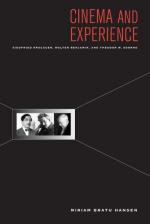|
This section contains 7,643 words (approx. 26 pages at 300 words per page) |

|
SOURCE: “Mimesis, Utopia, and Reconciliation: A Redemptive Critique of Adorno's Aesthetic Theory,” in The Terms of Cultural Criticism: The Frankfurt School, Existentialism, Poststructuralism, Columbia University Press, pp. 62-79.
In the following essay, Wolin examines the utopian elements of Adorno's aesthetics.
In 1980, Leo Lowenthal formulated a set of prescient insights about the future of Critical Theory in an interview entitled “The Utopian Motif is Suspended.”1 By “utopian motif,” Lowenthal was referring to the eschatological hopes for a better life in the here and now that inspired not only the enterprise of Critical Theory, but an entire generation of Central European Jewish thinkers who, like himself, came of age around the time of World War I and drew on utopian aspects of the Jewish tradition as a source of messianic inspiration.2 Among this generation, a decisive influence on the “inner circle” of Critical Theorists was exercised by the thought of...
|
This section contains 7,643 words (approx. 26 pages at 300 words per page) |

|


